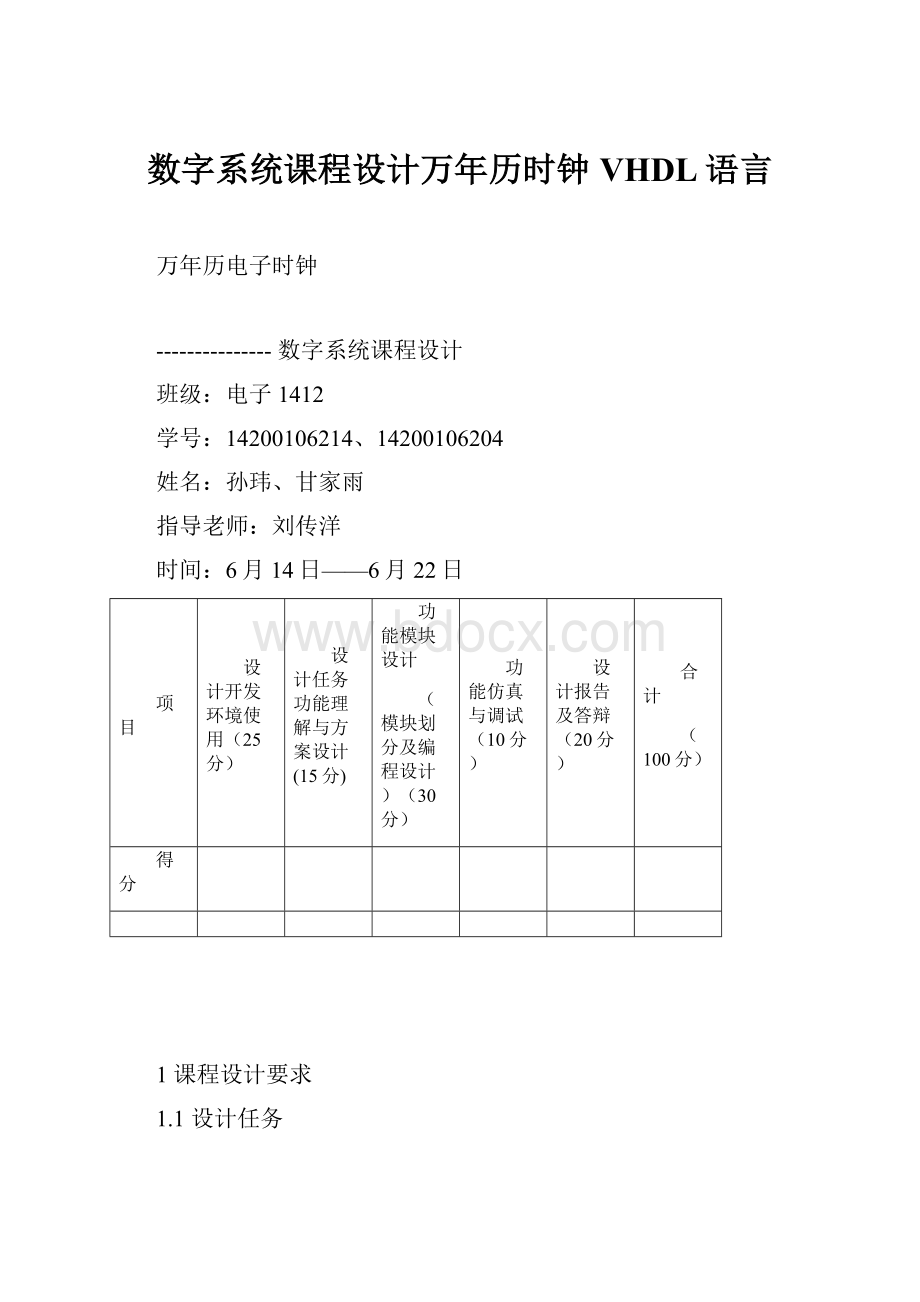数字系统课程设计万年历时钟 VHDL语言.docx
《数字系统课程设计万年历时钟 VHDL语言.docx》由会员分享,可在线阅读,更多相关《数字系统课程设计万年历时钟 VHDL语言.docx(31页珍藏版)》请在冰豆网上搜索。

数字系统课程设计万年历时钟VHDL语言
万年历电子时钟
---------------数字系统课程设计
班级:
电子1412
学号:
14200106214、14200106204
姓名:
孙玮、甘家雨
指导老师:
刘传洋
时间:
6月14日——6月22日
项目
设计开发环境使用(25分)
设计任务功能理解与方案设计(15分)
功能模块设计
(模块划分及编程设计)(30分)
功能仿真与调试(10分)
设计报告及答辩(20分)
合计
(100分)
得分
1课程设计要求
1.1设计任务
设计制作一个基于LCD1602显示,带有时间调整的万年历电子时钟。
1.2设计要求
1)采用硬件描述语言VHDL设计带有日期功能的数字电子时钟模块及LCD显示控制模块,并在Quartus-II环境下编译;
2)在Quartus-II环境下编辑仿真激励波形,并模拟;
3)在CPLD/FPGA实验板下载调试;
4)撰写设计报告,需要提供详细的设计方案分析、相关的参数计算过程、电路/系统组成、模块划分及其功能定义、程序设计、功能仿真及其结果分析、下载调试等内容。
1.3功能及性能指标要求
1)具有时钟的时、分、秒计数功能以及万年历的年、月、日功能;
2)年、月、日、时、分、秒数值采用字符型LCD1602显示;
3)具有对年、月、日、时、分时间数值调整功能,采用两个按键实现。
4)设计中时钟输入采用验证电路板上的50MHz作为基准;
5)程序设计尽可能考虑模块化、参数化设计思想,并遵循基本的格式规范,添加适当的注释及文档说明;
6)采用模块化设计方式,底层模块必须进行功能仿真;
2设计方案
根据课程设计要求,万年历电子时钟的设计框架图如图1所示。
图1设计框架图
由上图可知,万年历电子时钟由校时模块、LCD1602显示模块、分频模块、秒计数器、分计数器、时计数器、日计数器、月计数器和年计数器组成。
3模块分析
3.1秒计数器模块
秒计数器模块为60进制计数器,其有三个输入和三个输出,其中rst起复位作用,clk为1Hz的脉冲输入,stop为运行控制位,l为个位输出,h为十位输出,c为进位输出。
算法流程图如图2所示。
图2秒计数器算法流程图
源程序如下:
libraryieee;
useieee.std_logic_1164.all;
useieee.std_logic_unsigned.all;
entitycont_60sis
port(rst,clk,stop:
instd_logic;
l,h:
outstd_logic_vector(3downto0);
c:
outstd_logic);
endcont_60s;
architecturebehaveofcont_60sis
begin
process(clk,stop,rst)
variablell:
std_logic_vector(3downto0):
="0000";
variablehh:
std_logic_vector(3downto0):
="0000";
begin
if(rst='0')then
ll:
="0000";hh:
="0000";
elseifstop='0'then
ifclk'eventandclk='1'then
ll:
=ll+'1';
ifll="1010"then
ifhh="0101"thenhh:
="0000";ll:
="0000";c<='1';
elsell:
="0000";hh:
=hh+'1';c<='0';
endif;
elsec<='0';
endif;endif;
endif;endif;
l<=ll;h<=hh;
endprocess;
endarchitecturebehave;
秒计数器的波形仿真如图3所示。
如图所示,当秒计数器计数至59时,等待至clk上升沿到来时,进位输出c产生一个输出脉冲,同时秒计数器再次从0开始计数。
此外,当rst为0时h和l被置零,当stop为1时停止计时,所以设计正确。
图3秒计算器仿真图
3.2分计数器模块
分计数器模块为60进制计数器,其有两个输入和三个输出,其中rst起复位作用,clk为秒计数器的进位,l为个位输出,h为十位输出,c为进位输出。
算法流程图如图4所示。
图4分计数器算法流程图
源程序如下:
libraryieee;
useieee.std_logic_1164.all;
useieee.std_logic_unsigned.all;
entitycont_60mis
port(rst,clk:
instd_logic;
l,h:
outstd_logic_vector(3downto0);
c:
outstd_logic);
endcont_60m;
architecturebehaveofcont_60mis
begin
process(clk,rst)
variablell:
std_logic_vector(3downto0):
="0000";
variablehh:
std_logic_vector(3downto0):
="0000";
begin
if(rst='0')thenll:
="0000";hh:
="0000";
elseifclk'eventandclk='1'thenll:
=ll+'1';
ifll="1010"then
ifhh="0101"then
hh:
="0000";ll:
="0000";c<='1';
else
ll:
="0000";hh:
=hh+'1';c<='0';
endif;
elsec<='0';
endif;endif;endif;
l<=ll;h<=hh;
endprocess;
endarchitecturebehave;
分计数器的波形仿真如图5所示。
如图所示,当分计数器计数至59时,等待至clk上升沿到来时,进位输出c产生一个输出脉冲,同时分计数器再次从0开始计数。
此外,当rst为0时h和l被置零,所以设计正确。
图5分计算器仿真图
3.3时计数器模块
时计数器模块为24进制计数器,其有两个输入和三个输出,其中rst起复位作用,clk为分计数器的进位,l为个位输出,h为十位输出,c为进位输出。
算法流程图如图6所示。
图6时计数器算法流程图
源程序如下:
libraryieee;
useieee.std_logic_1164.all;
useieee.std_logic_unsigned.all;
entitycont_24is
port(rst,clk:
instd_logic;
l,h:
outstd_logic_vector(3downto0);
c:
outstd_logic);
endcont_24;
architecturebehaveofcont_24is
begin
process(clk,rst)
variablell:
std_logic_vector(3downto0):
="0000";
variablehh:
std_logic_vector(3downto0):
="0000";
begin
if(rst='0')thenll:
="0000";hh:
="0000";
elseifclk'eventandclk='1'thenll:
=ll+'1';
ifll="1010"thenll:
="0000";hh:
=hh+'1';
endif;
ifhh="0010"andll="0100"thenhh:
="0000";ll:
="0000";c<='1';
elsec<='0';
endif;endif;endif;
l<=ll;h<=hh;
endprocess;
endarchitecturebehave;
时计数器的波形仿真如图7所示。
如图所示,当时计数器计数至23时,等待至clk上升沿到来时,进位输出c产生一个输出脉冲,同时时计数器再次从0开始计数。
此外,当rst为0时h和l被置零,所以设计正确。
图7时计数器仿真图
3.4日计数器模块
日计数器模块为不规则的计数器,其有三个输入和三个输出,其中rst起复位作用,panduan用来输入平月、大月或小月,clk为时计数器的进位,l为个位输出,h为十位输出,c为进位输出。
算法流程图如图8所示。
图8日计数器算法流程图
源程序如下:
libraryieee;
useieee.std_logic_1164.all;
useieee.std_logic_unsigned.all;
entitycont_dayis
port(panduan:
instd_logic_vector(1downto0);
rst,clk:
instd_logic;
l,h:
outstd_logic_vector(3downto0);
c:
outstd_logic);
endcont_day;
architecturebehaveofcont_dayis
signalpan:
std_logic_vector(1downto0);
begin
process(clk,panduan,rst)
variablell:
std_logic_vector(3downto0):
="0001";
variablehh:
std_logic_vector(3downto0):
="0000";
begin
if(rst='0')thenll:
="0001";hh:
="0000";
elseifclk'eventandclk='1'then
ll:
=ll+'1';
ifll="1010"then
hh:
=hh+'1';ll:
="0000";
endif;
pan<=panduan;
casepanis
when"00"=>ifll="0010"andhh="0011"then
ll:
="0001";hh:
="0000";c<='1';
elsec<='0';
endif;
when"01"=>ifll="0001"andhh="0011"then
ll:
="0001";hh:
="0000";c<='1';
elsec<='0';
endif;
when"10"=>ifll="1001"andhh="0010"then
ll:
="0001";hh:
="0000";c<='1';
elsec<='0';
endif;
when"11"=>ifll="0000"andhh="0011"then
ll:
="0001";hh:
="0000";c<='1';
elsec<='0';
endif;
whenothers=>null;
endcase;
endif;endif;
l<=ll;h<=hh;
endprocess;
endarchitecturebehave;
日计数器的波形仿真如图9、图10、图11和图12所示。
如图所示,当panduan为00时,日计数器计数至31时,等待至clk上升沿到来时,进位输出c产生一个输出脉冲,当panduan为01时,日计数器计数至30时,等待至clk上升沿到来时,进位输出c产生一个输出脉冲,当panduan为10时,日计数器计数至28时,等待至clk上升沿到来时,进位输出c产生一个输出脉冲,当panduan为11时,日计数器计数至29时,等待至clk上升沿到来时,进位输出c产生一个输出脉冲,同时日计数器再次从1开始计数。
此外,当rst为0时h和l被赋初值,所以设计正确。
图9panduan为00时日计数器仿真图
图10panduan为01时日计数器仿真图
图11panduan为10时日计数器仿真图
图12panduan为11时日计数器仿真图
3.5月计数器模块
月计数器模块为12进制计数器。
此外,该模块还负责判断二月为28天还是29天,并将结果输出。
其有三个输入和三个输出,其中rst起复位作用,clk为日计数器的进位,run为闰年的判断输入,l为个位输出,h为十位输出,c为进位输出,pan为二月判断结果的输出。
算法流程图如图13所示。
图13月计数器算法流程图
源程序如下:
libraryieee;
useieee.std_logic_1164.all;
useieee.std_logic_unsigned.all;
entitycont_12is
port(rst,clk,run:
instd_logic;
c:
outstd_logic;
pan:
outstd_logic_vector(1downto0);
l,h:
outstd_logic_vector(3downto0));
endcont_12;
architecturebehaveofcont_12is
signallh:
std_logic_vector(7downto0);
begin
process(clk,rst)
variablell:
std_logic_vector(3downto0):
="0001";
variablehh:
std_logic_vector(3downto0):
="0000";
begin
if(rst='0')thenll:
="0001";hh:
="0000";
elseifclk'eventandclk='1'thenll:
=ll+'1';
ifll="1010"thenhh:
=hh+1;ll:
="0000";
endif;
ifhh="0001"andll="0011"thenll:
="0001";hh:
="0000";c<='1';
elsec<='0';
endif;endif;endif;lh<=hh≪
caselhis
when"00000001"=>pan<="00";
when"00000010"=>ifrun='1'thenpan<="11";
elsepan<="10";
endif;
when"00000011"=>pan<="00";
when"00000100"=>pan<="01";
when"00000101"=>pan<="00";
when"00000110"=>pan<="01";
when"00000111"=>pan<="00";
when"00001000"=>pan<="00";
when"00001001"=>pan<="01";
when"00010000"=>pan<="00";
when"00010001"=>pan<="01";
when"00010010"=>pan<="00";
whenothers=>null;
endcase;
l<=ll;h<=hh;
endprocess;
endarchitecturebehave;
月计数器的波形仿真如图14所示。
如图所示,当输入信号run为1时,即表示该年份为闰年,在2月份,输出判断信号pan为11,在大月,输出判断信号pan为00,在小月,输出判断信号pan为01,故设计正确。
当输入信号run为0时,即表示该年份为闰年,在2月份,输出判断信号pan为10,在大月,输出判断信号pan为00,在小月,输出判断信号pan为01,故设计正确。
图14月计数器仿真图
3.6年计数器模块
年计数器模块为1000进制计数器,但其无进位输出。
此外,该模块还负责判断判断闰年还是平年,并将结果输出。
其有两个输入和三个输出,其中rst起复位作用,clk为月计数器的进位,l为个位输出,h为十位输出,c为进位输出,run为闰年判断结果的输出。
千位计数器算法流程图如图15所示。
判断闰年的算法流程图如图16所示。
图15年计数器算法流程图
图16判断闰年算法流程图
源程序如下:
libraryieee;
useieee.std_logic_1164.all;
useieee.std_logic_unsigned.all;
entitycont_yearis
port(rst,clk:
instd_logic;
y1,y2,y3,y4:
outstd_logic_vector(3downto0);
run:
outstd_logic);
endcont_year;
architecturebehaveofcont_yearis
begin
process(clk,rst)
variableq1:
std_logic_vector(3downto0):
="0000";
variableq2:
std_logic_vector(3downto0):
="0000";
variableq3:
std_logic_vector(3downto0):
="0000";
variableq4:
std_logic_vector(3downto0):
="0010";
begin
if(rst='0')thenq1:
="0000";q2:
="0000";q3:
="0000";q4:
="0010";
elseifclk'eventandclk='1'thenq1:
=q1+'1';
ifq1="1010"thenq1:
="0000";q2:
=q2+'1';
endif;
ifq2="1010"andq1="0000"then
q2:
="0000";q3:
=q3+'1';
endif;
ifq3="1010"andq2="0000"andq1="0000"then
q3:
="0000";q4:
=q4+'1';
endif;
ifq3="1010"andq4="0000"andq2="0000"andq1="0000"then
q4:
="0000";
endif;
endif;
endif;
y1<=q1;y2<=q2;y3<=q3;y4<=q4;
endprocess;
process(clk,rst)
variableq5:
std_logic_vector(2downto0):
="000";
variableq6:
std_logic_vector(6downto0):
="0000000";
variablern:
std_logic:
='1';
begin
if(rst='0')thenq5:
="000";q6:
="0000000";
elseifclk'eventandclk='1'thenq5:
=q5+'1';
ifq5="100"thenq5:
="000";q6:
=q6+'1';
ifq6/=25andq6/=50andq6/=75thenrn:
='1';
elsern:
='0';
endif;
ifq6=100thenq6:
="0000000";
endif;
elsern:
='0';
endif;
endif;
endif;
run<=rn;
endprocess;
endarchitecturebehave;
年计数器的波形仿真如图17所示。
如图所示,每四年(除去不能被400整除的世纪年)为一闰年,其输出信号run为1,故设计正确。
图17年计数器仿真图
3.7校时模块
校时模块的主要功能是校对时间,而校时功能通过按键K1、K2来实现。
当不按K2按键时,计数器正常计时,而当按下K2按键时,根据所按的次数不同进入不同的工作模式,利用K1改变对应计数器的值,每按下K1,对应计数器的值加1。
其有七个输入和八个输出,分别为复位信号输入、时钟输入、进位输入、按键输入、进位输出和停止位输出。
校时模块的工作模式总共有6种,分别为正常计时、调分、调时、调日、调月和调年。
算法流程图如图18所示。
图18校时模块算法流程图
源程序如下:
libraryieee;
useieee.std_logic_1164.all;
useieee.std_logic_arith.all;
useieee.std_logic_unsigned.all;
entityjiaoshiis
port(rst,clk,mo,fo,so,ro,yo:
instd_logic;
k1,k2:
instd_logic;
fi,si,ri,yi,ni,stop:
outstd_logic);
endjiaoshi;
architecturebehaveofjiaoshiis
signala:
std_logic_vector(2downto0);
signalbuf1,buf2:
std_logic;
begin
process(k1,k2,clk,rst)
begin
ifclk'eventandclk='1'then
ifk1='0'thenbuf1<='1';
elsebuf1<='0';
endif;endif;
ifclk'eventandclk='1'then
ifk2='0'thenbuf2<='1';
elsebuf2<='0';
endif;
endif;
ifbuf2'eventandbuf2='1'then
a<=a+1;
ifa="101"then
a<="000";
endif;
endif;
if(rst='0')thena<="000";
endif;
caseais
when"000"=>stop<='0';fi<=mo;si<=fo;ri<=so;yi<=ro;ni<=yo;
when"001"=>stop<='1';fi<=buf1;si<='0';ri<='0';yi<='0';ni<='0';